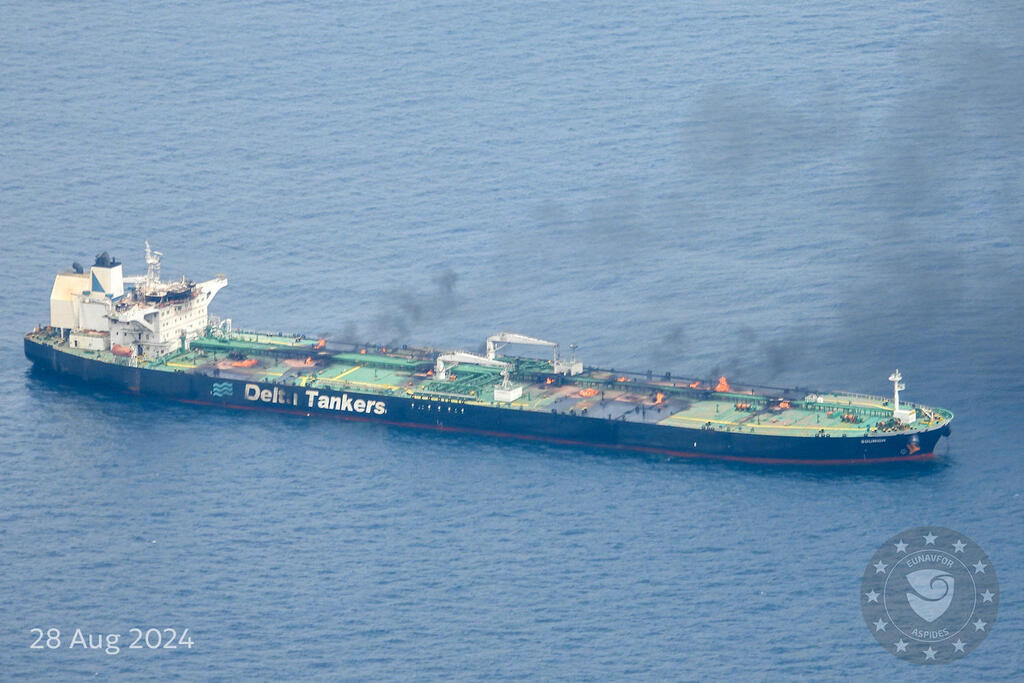Egypt had been anticipating the cease-fire in Gaza for several reasons, with one of the primary ones being economic: the Suez Canal, one of the country’s most vital sources of income, has suffered significant setbacks since October 7 due to the Houthi threat.
With the cease-fire agreement in Gaza and the cessation of Houthi attacks, Cairo hoped that activity in the canal would begin returning to normal. However, statements by U.S. President Donald Trump disrupted these expectations.
2 View gallery


Red Sea shipping loses billions in revenue due to war
(Photo: REUTERS/Stringer/File Photo)
Trump’s proposals regarding control of the Gaza Strip and relocating its residents to other countries not only provoked outrage across the Arab world—particularly from Egypt and Jordan, two nations that have opposed the relocation of Palestinians to their territories since the war’s outset—but also had indirect consequences, such as disrupting global shipping routes.
The Houthis, who naturally oppose Trump’s declarations, renewed their threats to intervene, claiming they would “support Gaza against displacement” by launching drones and missiles toward Israel. Shipping companies, which had been optimistic about resuming routes through the Suez Canal, once again pulled back, leaving Egypt to deal with ongoing challenges it had hoped were nearing resolution.
Chairman of the Suez Canal Authority, Osama Rabie, gave an interview last week on the Egyptian ONtv program The Last Word and stated, “Trump’s statements and the uncertainty they caused regarding the second phase of the cease-fire agreement have affected maritime traffic in the Red Sea.” He added that there had been expectations for significant improvement in the region following the halt of attacks from Yemen.
According to him, there were signs of progress, such as the passage of six U.S. and British ships through the Red Sea in January. Rabie also mentioned that an oil tanker attacked by the Houthis in July passed safely through the route in early February. He expressed optimism that the region was moving toward calm, but noted that shipping companies still preferred to avoid risks and opted for the Cape of Good Hope route instead.
When the interviewer, Lamis Al-Hadidi, asked whether Trump’s recent statements had increased regional tensions and potentially created further problems for the Suez Canal, Rabie replied, “That’s an accurate statement. The signs indicate ships are supposed to return to the Red Sea and the Suez Canal.”
Al-Hadidi further noted that there were no guarantees the Gaza cease-fire would hold, and asked, “Does this statement add to the concern?” Rabie responded, “Of course, it increases anxiety.” He predicted that maritime activity in the region would gradually recover by the end of March, with operations likely returning to normal by midyear.
Since the start of the war, the Houthis have targeted shipping routes through the Bab al-Mandab Strait, the Red Sea, and the Arabian Sea. They consistently claimed to attack vessels linked to Israel, owned by companies working with Israel, or heading to Israeli ports. This created a significant threat in the region, leading to a sharp decline in the number of ships choosing to sail through the Red Sea.
Many companies opted for the alternative route around Africa via the Cape of Good Hope. While this route is longer, it is considered safer. However, in March 2024, the threat to Israeli ships expanded to this route as well. Houthi leaders in Yemen, Abdul-Malik al-Houthi, and Houthi military spokesperson Yahya Saree, threatened to target Israeli vessels heading toward the Indian Ocean and the Cape of Good Hope.
The British Financial Times recently published an article titled “Trump’s Gaza proposal shatters hopes for Red Sea shipping recovery.” The article included interviews with senior shipping industry officials who stated that Trump’s plan had heightened regional tensions and increased the likelihood of renewed Houthi involvement.
It noted that the Houthis’ January announcement—stating they would only attack Israel-linked ships—had led to a slight uptick in vessels passing through Yemen, but many ships were still waiting for confirmation of regional stability before resuming their routes.
Lars Jensen, CEO of a company providing consulting services to shipowners and traders, was quoted in the article as saying, “Early hopes for a return to Red Sea shipping have been dashed. A week ago, there was light at the end of the tunnel, but now the likelihood of resuming Red Sea traffic is diminishing.”
Vincent Clerc, CEO of shipping giant Maersk, also spoke to the Financial Times, stating, “Returning to the Suez Canal is a complex process, and we need to ensure it’s not just for a few months. As long as there’s uncertainty about what the situation will look like in the coming weeks, we’ll wait.” According to Maersk, Red Sea trade could resume by mid-2025 in the best-case scenario, but in the worst-case scenario, it could remain limited until the end of the year.
Get the Ynetnews app on your smartphone: Google Play: https://bit.ly/4eJ37pE | Apple App Store: https://bit.ly/3ZL7iNv
The war has severely impacted Suez Canal revenues. According to Rabie’s latest report, losses are estimated at 61–62% of the canal’s projected revenue for the fiscal year ending in June 2025. Over the past 15 months, total losses are estimated at $6.8 billion, and if the current situation continues, the losses will grow further.
He noted that the daily number of ships crossing the canal currently stands at 30–32, compared to 72–75 in the past. Rabie also pointed out that since November 19, 2023, 10,517 ships have opted for the alternative Cape of Good Hope route: “All of these would have passed through the Suez Canal if not for the security threats.”
Despite the tense situation, economic crisis, and concerns about the future, Rabie announced last week the inauguration of the “Suez Canal Duplication Project,” allowing an additional 6–8 ships to pass through the canal daily. The project, which involves expanding the canal and creating a 6-mile dual section, is part of a broader plan to develop its southern sector.
The initiative was implemented following the Ever Given container ship incident in March 2021, which halted traffic for a week. Egypt hopes the expansion will boost the canal’s revenues, but for this to happen, ships need to return to the route. The Suez Canal Authority has been actively promoting the canal on social media to attract more shipping companies to resume their routes.



